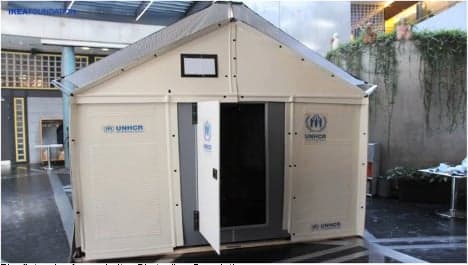UN agency tests Ikea refugee shelter

The Geneva-based UN refugee agency has turned to Swedish furniture giant Ikea to make more durable and functional shelters for refugees world-wide.
The first prototypes of the new shelters — which come in flatpack boxes and which can be assembled in just four hours without tools — will soon be rolled out, the agency said on Friday.
"We will set up 26 (ready-to-assemble shelters) which have already arrived in Ethiopia," head of innovation at UNHCR, Oliver Delarue, told AFP.
"Twelve will soon arrive at the Iraqi border for Syrian refugees and 12 in Lebanon, also for Syrians."
Refugee camps today often consist of overcrowded tents that can be sweltering hot during the day and freezing at night, with no electricity and thus no light or heat after nightfall.
UNHCR hopes that could become a thing of the past, as it prepares to roll out 50 cottage-like shelter prototypes with flexible solar panels on the roofs for power and specially-made walls that can deflect heat during the day and retain it at night.
Ikea's philanthropist foundation has funded the project to the tune of $4 million, while a Sweden-based group called the Refugee Housing Unit has been working with the UN agency on the design.
The prototypes, with their semi-hard plastic walls and roofs made from composite material and with room to house five people each, have cost $8,000 a piece, and UNHCR wants to wait for feedback from refugees before giving a green light to more wide-scale production.
Over time, the UN agency expects the unit price for the new shelters to come down to around $1,000, which is still double the $500 it currently pays for each of its refugee tents.
The prototype shelters were all made by hand in Sweden, although not in Ikea factories, Delarue said, insisting that the Ikea Foundation's participation in the project was not commercially motivated.
One of the main advantages with the new shelters is their durability, he said, pointing out that UNHCR's traditional canvas refugee tents rarely last much longer than six months in climates like those found in countries like Jordan or South Sudan.
The new shelters have been guaranteed to last three years and will likely remain standing for longer than that, Delarue said.
That is a big plus considering that refugees on average live in their UNHCR shelters for 12 years.
Transport remains a challenge, though, since the shelter kits weigh 100 kilos each, compared to just 60 kilos for the average tent.
More than 15 million people were living as refugees around the world last year, while another nearly 29 million were displaced within their own country -- the highest combined number in two decades, according to UNHCR statistics released last week.
Comments
See Also
The first prototypes of the new shelters — which come in flatpack boxes and which can be assembled in just four hours without tools — will soon be rolled out, the agency said on Friday.
"We will set up 26 (ready-to-assemble shelters) which have already arrived in Ethiopia," head of innovation at UNHCR, Oliver Delarue, told AFP.
"Twelve will soon arrive at the Iraqi border for Syrian refugees and 12 in Lebanon, also for Syrians."
Refugee camps today often consist of overcrowded tents that can be sweltering hot during the day and freezing at night, with no electricity and thus no light or heat after nightfall.
UNHCR hopes that could become a thing of the past, as it prepares to roll out 50 cottage-like shelter prototypes with flexible solar panels on the roofs for power and specially-made walls that can deflect heat during the day and retain it at night.
Ikea's philanthropist foundation has funded the project to the tune of $4 million, while a Sweden-based group called the Refugee Housing Unit has been working with the UN agency on the design.
The prototypes, with their semi-hard plastic walls and roofs made from composite material and with room to house five people each, have cost $8,000 a piece, and UNHCR wants to wait for feedback from refugees before giving a green light to more wide-scale production.
Over time, the UN agency expects the unit price for the new shelters to come down to around $1,000, which is still double the $500 it currently pays for each of its refugee tents.
The prototype shelters were all made by hand in Sweden, although not in Ikea factories, Delarue said, insisting that the Ikea Foundation's participation in the project was not commercially motivated.
One of the main advantages with the new shelters is their durability, he said, pointing out that UNHCR's traditional canvas refugee tents rarely last much longer than six months in climates like those found in countries like Jordan or South Sudan.
The new shelters have been guaranteed to last three years and will likely remain standing for longer than that, Delarue said.
That is a big plus considering that refugees on average live in their UNHCR shelters for 12 years.
Transport remains a challenge, though, since the shelter kits weigh 100 kilos each, compared to just 60 kilos for the average tent.
More than 15 million people were living as refugees around the world last year, while another nearly 29 million were displaced within their own country -- the highest combined number in two decades, according to UNHCR statistics released last week.
Join the conversation in our comments section below. Share your own views and experience and if you have a question or suggestion for our journalists then email us at [email protected].
Please keep comments civil, constructive and on topic – and make sure to read our terms of use before getting involved.
Please log in here to leave a comment.